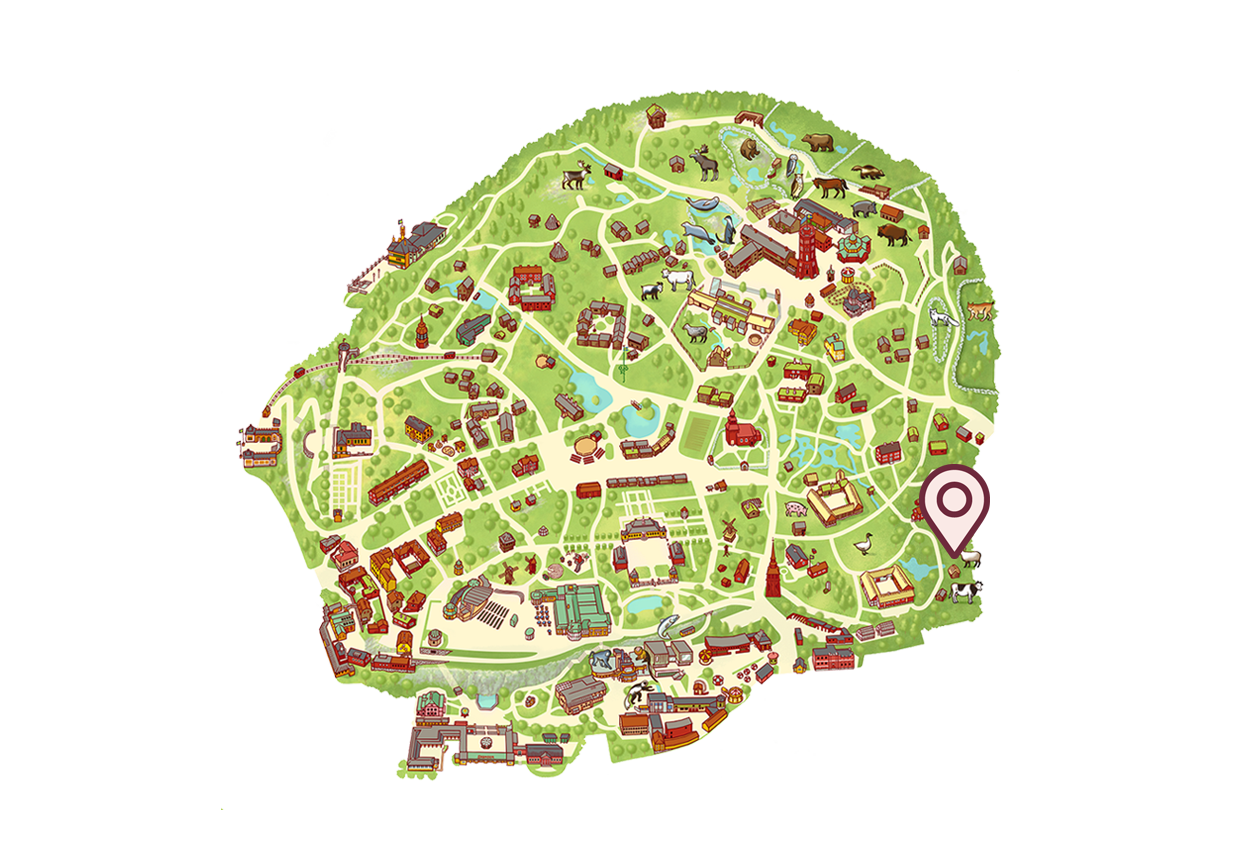- See and do
- The Zoo
- Animals at Skansen
- Gute sheep
Gute sheep
The Gute sheep has existed on the Swedish islands of Gotland and Fårö ever since man first came there to settle. It is a Swedish native breed sheep. Like other native breed sheep, Gute sheep are hardy and are well adapted to living outdoors all year round.
-
The Gute sheep is a typical native breed that is hardy, vigorous, productive and easily bred. They are tall and nimble, with a shorter tail than imported breeds. They have a strong herd instinct, but may spread out when grazing – unlike other sheep. The flock is often led by an older ewe. The ewes give birth in March or April, or sometimes earlier. The Gute sheep’s diet consists of grass, herbs and bushes. They are good feed converters, and can feed on brushwood pasture which gives their meat a gamey flavour.
Both rams and ewes have horns
Gute sheep have smooth, woolless faces and straight nose bridges, and tend to be pale-coloured around the muzzle and the eyes. However, old rams often have a convex nose bridge. Both rams and ewes have horns, and rams often have thick manes. They have a lot of kemp hair and dead hair.
Gute sheep vary widely in colour, ranging from brown to grey, and a few are single-coloured. They can be completely black, but never completely white. Some are piebald. They have slim legs that are often reddish-yellow in colour. They usually have short, hairy tails, but they never have wool at the tip of the tail.
Moults in the spring
Some Gute sheep have ancient traits, such as shedding their coat in the spring. Just as would have been done in the past, the wool can be then pulled off instead of cutting. This is called rooing. The Gute sheep’s wool does not need to be carded or combed, and can be spun straight away.
-
About the Gute sheep
Scientific name:Ovis aries domesticus
Order:Even-toed ungulates
Family:Hollow-horned animals
Weight:Female (ewe) 40–45 kg and male (ram) 70–80 kg. Newborn lamb 2.5 kg. Weight after slaughter 15–20 kg.
Height at the withers:70–75 cm
Sexual maturity:6–7 months
Breeding season:Autumn
Gestation:5 months
Number of young:1–2. Rarely 3. The ewes give birth to lambs easily, and are good mothers. Twins are common. The ewes actively defend their lambs using their horns.
Lifespan:Approx. 10 years
-
The Gute sheep has different types of wool on different parts of its body. The undercoat keeps the sheep warm. The overhair ensures that water runs off easily and prevents the undercoat from felting. The overhair is filled with air that retains heat and loosens up the undercoat so that the wool does not blow apart, resulting in loss of warmth. There is also long, coarse, marrow-filled overhair, known as kemp hair. The kemp hair is shed after a few months of growth and becomes dead hair. In rams in particular, this can form a dark ‘lion’s mane’ around the neck made up of about 15 cm of dead hair.
Derives from Gotland’s outdoor sheep
Gute sheep have been on Gotland and Fårö ever since humans first settled there. They are descended from the ancient Gotland outdoor sheep, which have many similarities with wild sheep. Towards the end of the 19th century, sheep breeding had begun to shift towards hornless animals. It was thought that the horns developed at the expense of the meat.
People wanted their domesticated animals to have several different useful qualities. Sheep provided meat and wool, as well as milk for making cheese. The different qualities of the Gute sheep’s wool meant that materials could be obtained for different fabrics.
Conservation work
In the 1920s, a man by the name of Edward Graelert bought a farm on the island of Gotland, including Gotland’s outdoor sheep with their original large, curved horns. This was the only herd with horns until 1937. The Swedish Society for Nature Conservation and Skansen realised that these sheep were disappearing, and in 1938 Skansen bought a ram and two ewes. In the 1940s, the animals were sold on to places like Slottsskogen City Park in Gothenburg. Today, several animal parks and individuals are involved in conservation work, and the breed is considered to have been saved. The name ‘Gute sheep’ was coined in 1973, from the short Swedish word for Gotlandic.
Special feeding hut
The feeding hut is a traditional Gotland structure where outdoor sheep and ponies can seek shelter and be fed during the winter. The animals can enter and leave via an opening on the ground floor, and hay and leaves are stored above.
-
Native breeds
Native breeds are populations of domesticated animals that have lived for so long in the same area that they have adapted to the local environment and its specific conditions. Swedish native breeds have declined in number, but there is a growing focus on efforts to preserve them as they are an important genetic resource and part of our cultural heritage.
Find out more about Swedish native breeds here.
You can find the Gute sheep here
